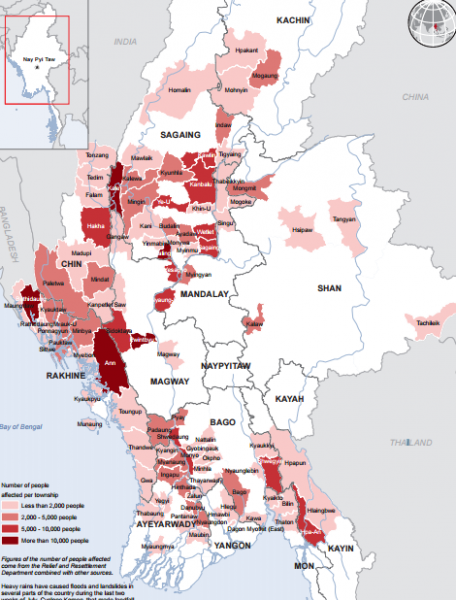How Social Media Moved People to Act in Flood-Ravaged Myanmar

Myanmar’s flooding crisis, caused by several days of monsoon rains and Cyclone Komen, has affected 330,000 people already in 12 states and destroyed a million acres of farmland. This is the largest natural disaster to hit the country since Cyclone Nargis killed more than 100,000 people in 2008. But unlike in 2008 when people relied heavily on government broadcasts for information, many residents today are able to monitor the flood situation through social media.
Chit Win, a PhD student at the Australian National University, observed how social media allowed people to verify the impact of the floods:
'During Cyclone Nargis we knew very little and were told very late about the situation and how the disaster was being handled. This time the flood is being covered minute-by-minute via social media and we can see how authorities have responded, for better or for worse.'
Aside from providing realtime information about the floods, social media also inspired many to give donations or to organize relief missions. Some of the popular Twitter hashtags used to mobilize volunteers are #MyanmarFlood and #SaveMyanmar.
Ma Khin Zar Mon, a volunteer with the Facebook group People to People, recognized the widespread use of social media today compared to the absence of these popular online tools in 2008:
'We did not have so many volunteer groups at that time. This year, there are a lot of volunteers who are coming out to help people. Of course, social media is the main part.'
Through social media, some flood victims are able to complain about the slow delivery of aid. A viral video on Facebook showed how the military wasted some relief goods by dropping a bag of rice on muddy waters.
It was also on Facebook that the government apologized for the mistake:
'We feel very sorry to learn that some relief items fell into the mud, and some [sacks] were broken. We are trying not to repeat that kind of incident.'
Meanwhile, a junior official from the Irrigation Department became famous by providing constant information about irrigation dams to counter online rumours suggesting many had been destroyed.
At the time of writing, he already has 24,000 Facebook followers.
Room for solidarity
In the meantime, some have been getting creative in sending relief to flood victims, like this former sailor who built a boat made from empty water bottles:

The cartoons below reflect the sentiments of many: there is sense of solidarity on one hand but also disappointment with a slow government response.


A partly man-made disaster
Environmental degradation is at the root of severe flooding in Myanmar. But as Ko Aye Chan Maung, another student at Australian National University, explains, much could have been done to mitigate the effects of the deluge.
'Deforestation, unsustainable land-use practices, damming projects and lack of policy initiatives for disaster risk management have compounded the effects of these latest torrential rains.
Damming rivers and streams and blocking natural water ways contributed to unlikely floods in some parts of the country. This has worsened because of a lack of well-planned risk management strategies.'
Like in 2008, the international community has been quick in delivering relief to the flooded regions over the last few days.
This article by Mong Palatino originally appeared on Global Voices on August 7th 2015.









